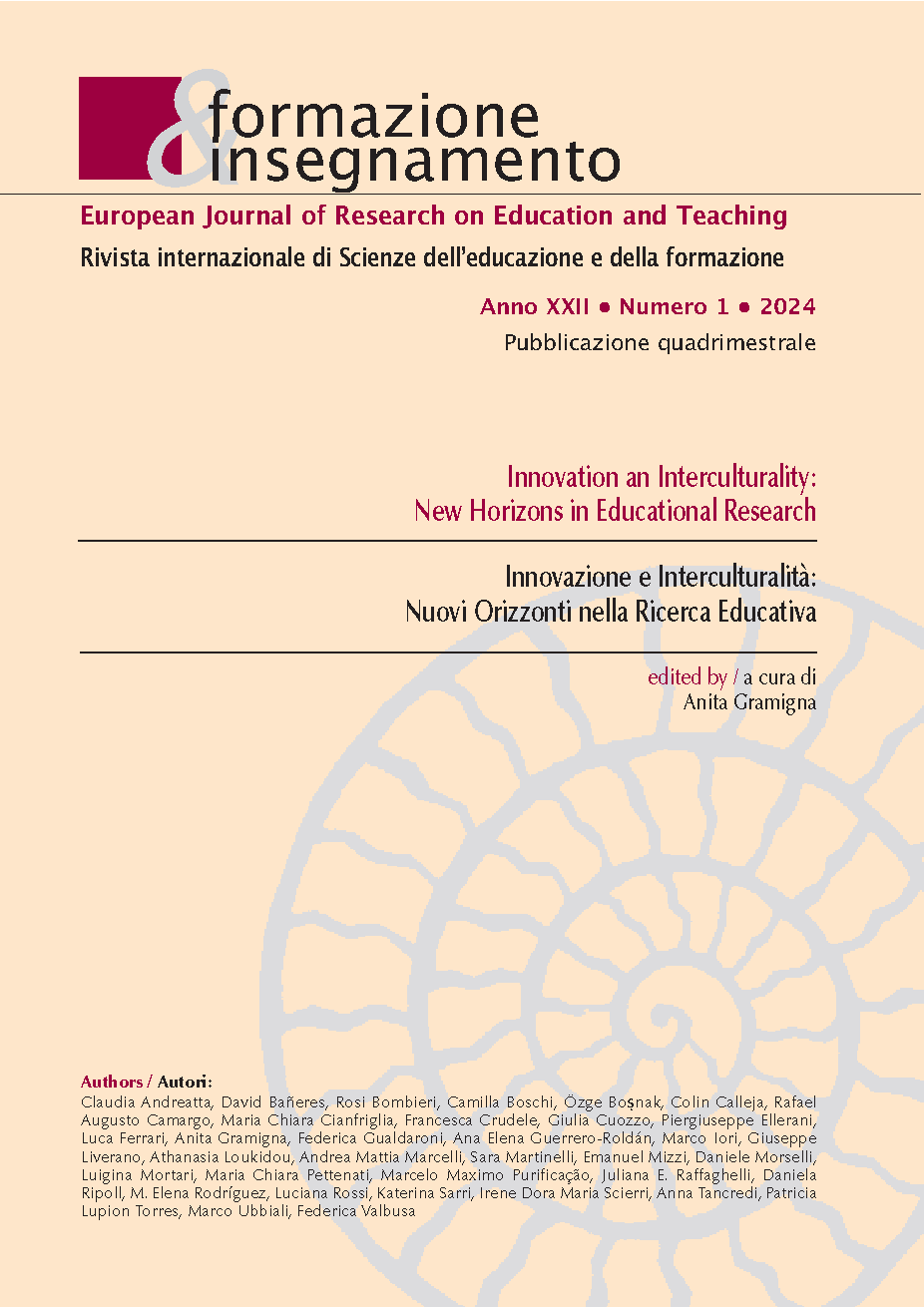A Contribuição dos Ecossistemas de IA Generativa no Micro-Design Instrucional: Oportunidades e Limitações
DOI:
https://doi.org/10.7346/-fei-XXII-01-24_13Palavras-chave:
Inteligência Artificial, Planejador Pedagógico, Profissionalismo docente, Design InstrucionalResumo
Os Planejadores Pedagógicos [Pedagogical Planners] (PP) são ambientes digitais desenvolvidos ad hoc com o objetivo de auxiliar professores a tornar visível (e metodologicamente fundamentado) o processo de ideação e implementação de experiências de ensino-aprendizagem. A adoção desses ambientes no contexto educacional foi inicialmente limitada pela falta de aplicações específicas, pela baixa disseminação desses sistemas nas escolas e por algumas limitações relacionadas à 'estaticidade' das propostas instrucionais geradas por essas ferramentas. No entanto, em tempos mais recentes, a integração de algoritmos de Inteligência Artificial generativa dentro dos PP, como os Planejadores de Aula IA [AI Lesson Planner], abre novos desafios educacionais e perspectivas inéditas de pesquisa educacional. Isso também levanta questões sobre o verdadeiro papel do professor dentro dele.
Referências
Antonenko, P., Abramowitz, B. (2023). In-service teachers’ (mis)conceptions of artificial intelligence in K-12 science education, Journal of Research on Technology in Education, (55)1, 64-78, https://doi.org/10.1080/15391523.2022.2119450
Baldacci, M. (2012). Trattato di pedagogia. Roma: Carocci.
Bertin, G. M. (1968). Educazione alla ragione. Roma: Armando Editore.
Bertolini, P. (1983). Pedagogia e scienze umane. Bologna: CLUEB.
Bottino M. R, Ott, M. Tavella M. (2011). Pedagogical planning and sustainability of learning actions: the Iamel system. Tecnologie Didattiche, 19(3), 147-154, https://doi.org/10.17471/2499-4324/207
Cameron, L., & Campbell, C. (2010). Sharing learning designs that work. Proceedings of World Conference on Educational Multimedia, Hypermedia and Telecommunications. Chesapeake, VA: AACE.
Conole, G., & Fill, K. (2005). A learning design toolkit to create pedagogically effective learning activities. Journal of Interactive. Media in Education, 8(1) https://doi.org/10.5334/2005-8
Costa, N. Pereira Junior, C., Araujo, R., Fernandes, M. (2019). Application of AI Planning in the Context of e-Learning, IEEE Computer Society, 57-59, https://doi.org/10.1109/ICALT.2019.00021
Dalziel J. (2003). Implementing learning design: the learning activity management system (LAMS). In G. Crisp, D. Thiele, I. Scholten, S. Barker, J. Baron (eds.). Proceedings of the 20th Annual Conference of the Australasia Society for Computers in Learning in Tertiary Education (AS-CILITE). Interact, Integrate, Impact (Adelaide, Australia, 7-10 december 2003). ASCILITE, 593-596.
Dillenbourg, P. (2002). Over-scripting CSCL: The risks of blending collaborative learning with instructional design. In P. A. Kirschner (Ed.). Three worlds of CSCL: Can we support CSCL (pp. 61–91). Heerlen, The Netherlands: Open Universiteit Nederland.
Dong, Y. (2023). Revolutionizing Academic English Writing through AI-Powered Pedagogy: Practical Exploration of Teaching Process and Assessment. Journal of Higher Education Research, 4(2), pp.52-57. https://doi.org/10.59400/fls.v6i2.1177
Fabbri, M. (2018). Oltre il disagio. Percorsi di crisi, orizzonti di civiltà. Milano: Franco Angeli.
Ferrari, L (2015). Costruire esperienze didattiche di online collaborative learning. Parma: Junior.
Kehoe, F. (2023). Leveraging Generative AI Tools for Enhanced Lesson Planning in Initial Teacher Education at Post Primary. Irish Journal of Technology Enhanced Learning, 7(2), 172-182, https://doi.org/10.22554/ijtel.v7i2.124
Laurillard, D. (2014), Insegnamento come progettazione. Milano: FrancoAngeli.
Margiotta, U. (a cura di) (2018). Teacher Education Agenda. Linee guida per la formazione iniziale dei docenti della scuola secondaria. Trento: Erickson.
Masterman, E., Manton, M. (2011). Teachers’ perspectives on digital tools for pedagogic planning and design. Technology, Pedagogy and Education, 20(2), 227-246. https://doi.org/10.1080/1475939X.2011.588414
Masterman, E., Walker, S., & Bower, M. (2013). Computational support for teachers’ design thinking: Its feasibility and acceptability to practitioners and institutions. Educational Media International, 50, 12-23. https://www.learntechlib.org/p/132440/
Miller, A. L. (2023). AI Assisted Learning: A Tool or a Threat? Journal of e-learning Research, 2(2), 52-65, https://doi.org/10.33422/jelr.v2i2.510
Mor Y., Warburton S., Winters N., Mellar H. (eds.) (2014). Practical design patterns for teaching and learning with technology. Rotterdam: Sense.
Nerantzi, C., Abegglen, S., Karatsiori, M., Martinez-Arboleda, A. (2023). 101 Creative ideas to use AI in education. A collection curated by #creativeHE.
OECD (2010). Inspired by Technology, Driven by Pedagogy. A Systemic Approach To Technology-Based School Innovations. Paris: OECD Publishing.
Persico, D. & Pozzi, F. (2013). Sustaining Learning Design and Pedagogical Planning in CSCL. Research in Learning Technology, 21, https://doi.org/10.3402/rlt.v21i0.17585
Pozzi, F., Asensio-Perez, J. I., Ceregini, A., Dagnino, F. M., Dimitriadis, Y., & Earp, J. (2020). Supporting and representing Learning Design with digital tools: in between guidance and flexibility. Technology, Pedagogy and Education, 29(1), 109-128, https://doi.org/10.1080/1475939X.2020.1714708
Rossi, P.G. (2014), Le tecnologie digitali per la progettazione didattica. Journal of Educational, Cultural and Psychological Studies (ECPS Journal), [S.l.], 10, 113-133, https://doi.org/10.7358/ecps-2014-010-ross
Rossi, P.G. (2016). Progettazione didattica e professionalità docente. PROPIT: l’artefatto progettuale come mediatore didattico. In P.G. Rossi, C. Giaconi (a cura di). Micro-progettazione: pratiche didattiche a confronto PROPIT, EAS, Flipped Classroom. Milano: Franco Angeli.
Rivoltella P. C. (2012). Neurodidattica. Insegnare al cervello che apprende. Milano: Raffaello Cortina.
San Diego, J. P., Laurillard, D., Boyle, T., Bradley, C., Ljubojevic, D., Neumann, T., Pearce, D. (2008). Towards a user-oriented analytical approach to learning design. ALT-J, 16(1), 15-29. http://dx.doi.org/10.1080/09687760701850174
Winograd, T. (1996). Bringing design to software. New York, NY: ACM Press.
Yue, M., Jong, M.S., Dai, Y. (2022). Pedagogical Design of K-12 Artificial Intelligence Education: A Systematic Review. Sustainability 14, 15620. https://doi.org/10.3390/su142315620
Downloads
Publicado
Como Citar
Edição
Seção
Categorias
Licença
Copyright (c) 2024 Piergiuseppe Ellerani, Luca Ferrari

Este trabalho está licenciado sob uma licença Creative Commons Attribution 4.0 International License.
Formazione & insegnamento é distribuído sob a Attribution 4.0 International (CC BY 4.0).
Para obter mais detalhes, consulte nossa Política de Repositório e Arquivamento, bem como nossos Termos de Direitos Autorais e Licenciamento.





